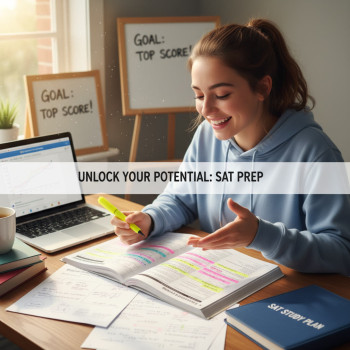Why SAT Scores Still Matter — Even in a Test-Optional World
Let’s start with a short, honest conversation. You’ve probably heard that many colleges adopted test-optional policies in recent years. That’s true. But test-optional doesn’t mean test-irrelevant. For students and parents navigating the college application process, especially those aiming for STEM or arts programs, SAT scores still play a powerful, strategic role.
Think of the SAT like a loud, clear microphone at a fair where college admissions teams are trying to hear which students are prepared for the academic work ahead. Grades tell a story — but they can be influenced by course selection, school rigor, and even circumstances outside a student’s control. A strong SAT (now in digital format) gives a standardized read on key skills: quantitative reasoning, problem solving, critical reading, and data literacy. Admissions officers often use that read as a complement — not a replacement — for transcripts, essays, recommendations, and portfolios.

STEM vs Arts: How Admissions Priorities Diverge
Colleges aren’t monolithic. STEM programs and arts programs look for different signals when evaluating applicants. Understanding those differences will help you decide when to send SAT scores and when to emphasize other parts of your application.
What STEM Departments Often Value
- Quantitative readiness — comfort with algebra, geometry, and data interpretation.
- Consistency in rigorous coursework (AP/IB/honors math and science classes).
- Standardized evidence that predicts success in first-year STEM courses — here the SAT Math—or its digital math equivalents—can be influential.
- Research, internships, math competitions, or engineering projects that show initiative and depth.
What Arts and Humanities Programs Often Value
- Depth of creative work: portfolios, performances, films, writing samples, or curated exhibits.
- Contextual academic performance — strong writing and critical thinking more than purely quantitative measures.
- Fit and voice: compelling personal statements, recommendation letters attesting to originality, and demonstrated arts engagement.
- For some competitive programs, SAT scores still help for scholarships or to confirm readiness for liberal arts coursework.
Where SAT Scores Help STEM Applicants Most
For students aiming at majors like engineering, computer science, physics, or statistics, strong SAT performance has concrete benefits:
- Admissions clarity — high math/quantitative scores reduce uncertainty about a student’s readiness for calculus-based sequences.
- Placement advantages — some colleges use SAT scores for course placement, which can save time and tuition by skipping remedial courses.
- Scholarship eligibility — many merit-based awards still use SAT benchmarks as part of their criteria.
- Recruitment visibility — participating in the Student Search Service can get STEM programs’ attention when scores and interests align.
Example: Two Hypothetical STEM Applicants
Imagine two students applying to the same engineering school. Both have A- averages. Student A has a 760 math section on the SAT and strong AP Calculus scores. Student B has a 620 math section but a stellar project-based engineering internship. Admissions may view Student A as lower-risk for intense quantitative coursework, while Student B may be seen as promising but potentially in need of foundational support.
In short: a high SAT math score is often a simple, persuasive signal that can tip decisions when applicants are otherwise similar.
Where SAT Scores Help Arts Applicants — and Where They Don’t
Arts applicants have a different toolkit to showcase strengths. For studio art, theatre, creative writing, film, and design, the portfolio or audition usually carries the heaviest weight. But SAT scores still matter in subtle ways:
- Complementary evidence — a strong SAT Reading/Writing score reassures committees that the student can thrive in coursework that involves heavy reading, theory, or critique.
- Scholarships and departmental funding — some arts scholarships use SAT thresholds as part of eligibility.
- Test-optional strategy — if an arts applicant’s SAT is below institutional averages, they might opt not to submit; but if it’s solid, it can broaden options by making them eligible for programs that still consider scores.
Example: Two Hypothetical Arts Applicants
Picture two applicants for a competitive art program. Applicant X has an extraordinary portfolio and an SAT Reading/Writing score at the national average. Applicant Y has an exceptional portfolio but a low SAT score. The portfolio is X and Y’s primary voice, but Applicant X’s SAT helps remove academic doubts and may strengthen scholarship chances. Applicant Y should compensate by highlighting coursework rigor, teacher recommendations, and contextual factors that explain the score.
How To Decide Whether to Submit SAT Scores
Deciding to submit scores is strategic, not binary. Consider this quick decision framework:
- Does your score fall above the middle 50% range of admitted students at your target school? If yes, strongly consider submitting.
- Are you applying to a STEM major where quantitative readiness is crucial? If yes, a strong math score is often an advantage.
- Is your portfolio or audition the primary evaluation tool (arts conservatory or performance-based program)? Then prioritize showcasing that; submit scores only if they strengthen scholarship or placement chances.
- Do you have context that explains a lower score (illness, school disruption)? If so, pair your application with a short context explanation and stronger work elsewhere.
Concrete Benchmarks: What “Good” Looks Like
Admissions teams often publish score ranges. Below is a simple sample table to help you visualize how different score bands interact with admissions and scholarship opportunities. Treat this as a directional guide rather than a strict rule — each college interprets scores differently.
| Score Band (Total / Evidence-Based Reading & Writing / Math) | Admissions Signal | Typical Implication for STEM | Typical Implication for Arts |
|---|---|---|---|
| 1400–1600 (700–800 / 700–800) | Very strong academic readiness | Competitive at top STEM programs; may unlock scholarships | Strengthens interdisciplinary candidacy and scholarships |
| 1200–1390 (600–700 / 600–700) | Solid; in-range for many selective colleges | Shows readiness for core STEM courses; good for state flagships | Comfortable for arts programs; portfolio remains primary |
| 1000–1190 (500–600 / 500–600) | Average to below-average for selective colleges | May need stronger coursework or AP scores to stand out | Portfolio and recommendations become crucial; consider optional submission |
| <1000 (<500 / <500) | Likely harms competitiveness at selective schools | Consider retesting or highlighting alternative evidence | Focus on portfolio, contextual narrative, and local programs |
How Digital SAT Changes the Picture
The SAT’s move to a digital format brought a few practical differences that matter for both STEM and arts students:
- Shorter testing time and adaptive sections can change pacing strategy.
- Tool availability (such as an on-screen calculator for some math items) shifts the importance of mental math vs calculator fluency.
- Digital practice resources and official digital practice tests allow targeted, platform-specific training.
For STEM students, becoming comfortable with digital data presentation, interpreting graphs on-screen, and using the calculator efficiently can raise scores. For arts students, the on-screen reading passages and writing tasks mirror classroom digital literacy demands and often reward clarity and organization, both in essays and in portfolio statements.
Practical Prep: What Works for STEM vs Arts Students
Preparation isn’t one-size-fits-all. The good news: you can tailor practice to your goals and make efficient gains.
Study Strategies for STEM-Focused Students
- Targeted math practice: focus on algebra, functions, and data analysis. Benchmarks and error logs help identify patterns of mistake.
- Timed sections that simulate the Digital SAT’s adaptive rhythms so you build stamina and pacing.
- Use practice problems that are heavy on multi-step reasoning and real-world data interpretation.
- Pair SAT prep with AP or dual-enrollment coursework to demonstrate depth.
Study Strategies for Arts-Focused Students
- Build reading comprehension with diverse texts — criticism, essays, close readings — to sharpen contextual analysis.
- Practice writing concise, compelling responses; admissions essays and SAT Writing sections reward clarity.
- Use portfolio time to refine themes and ensure written materials (artist statements, CVs) are polished.
- Consider whether submitting a strong SAT score could unlock scholarships or strengthen a cross-disciplinary application.
How Parents Can Support Without Micromanaging
Parents play a huge role by setting the tone: supportive, strategic, and calm. Here’s how to be helpful:
- Frame prep as skill-building, not just test-chasing. That reduces stress and fosters lasting academic habits.
- Help create a predictable schedule for practice, portfolio work, and rest days.
- Be the accountability partner who celebrates progress; avoid turning practice into pressure.
- Encourage targeted help when needed — a tutor or a focused program can be more efficient than unguided hours of practice.
When to Consider Personalized Tutoring (and What to Expect)
Many students see bigger returns when they pair self-study with focused, personalized instruction. Personalized tutoring offers advantages that matter differently for STEM and arts applicants:
- 1-on-1 guidance to zero in on weak spots — whether that’s algebraic manipulations or persuasive writing structure.
- Tailored study plans that fit busy schedules and prioritize high-yield skills and question types.
- Expert tutors who simulate real test conditions, review errors, and keep students accountable.
- AI-driven insights (when available within a tutoring program) that track progress and suggest targeted practice — helping students improve faster with less wasted time.
For example, Sparkl’s personalized tutoring model blends expert tutors and tailored study plans to help students improve efficiently. For a STEM-bound student, a tutor can focus on the math topics that deliver the biggest score gains; for an arts student, a tutor can refine reading strategies and craft stronger application essays. When tutoring fits naturally into a student’s plan, it becomes not just preparation for a test, but preparation for college-level thinking.
Balancing Portfolio Development and Test Prep for Arts Students
Time management matters. If you’re an arts student, devote the lion’s share of effort to a standout portfolio or audition, but don’t neglect the SAT entirely. Even a modest improvement in reading/writing scores can increase scholarship options and reduce uncertainty.
Try a simple schedule split during your final year: 70% portfolio/audition work and 30% SAT-targeted prep. If deadlines cluster, prioritize the application piece due first, then switch focus. Short, regular practice sessions (e.g., 30–45 minutes, three times a week) on the Digital SAT platform keep skills sharp without stealing creative energy.
Real-World Context: How Admissions Officers Use the Whole Picture
Admissions officers read applications holistically. That means they weigh test scores in context: course rigor, letters, extracurriculars, essays, and portfolios. A middling SAT score won’t automatically sink a stellar portfolio, but it might affect placement decisions, scholarship eligibility, or the safety of a student’s application plan.
Admissions teams often tell students that the SAT is a tool to remove uncertainty. If you can remove doubt about your academic readiness with a strong score, you’re helping the committee say “yes.” If your strengths are elsewhere — unique creative work or leadership — build a narrative that explains and elevates those strengths.
Action Plan: Step-by-Step for the Next 6 Months
- Month 1: Take a timed digital practice test to get a baseline. Review errors and identify top three weaknesses.
- Months 2–3: Focused practice blocks (math fundamentals for STEM; reading and writing craft for arts). Consider a weekly 1-on-1 tutor session to accelerate improvement.
- Month 4: Simulate test days twice, review timed strategies, and finalize portfolio drafts or audition repertoire.
- Month 5: Take an official Digital SAT if you’re aiming to submit scores; otherwise, refine portfolio/audition and craft essays.
- Month 6: Polish application materials, confirm score-sending decisions, and finalize submissions.
Final Thoughts: Strategy, Not Stress
At its best, the SAT is a tool — a standardized, objective measure that can unlock opportunities, clarify readiness, and sometimes pay for college through scholarships. For STEM applicants, an excellent SAT math performance can be a powerful differentiator. For arts applicants, portfolios and auditions remain the heart of the application, but a solid SAT reading/writing score can smooth the path and expand financial opportunities.
Remember: the smartest plan is the one that fits the student. Combine honest diagnostic testing, focused practice, and targeted support. When the plan is personalized — whether that’s through school counselors, a trusted tutor, or programs like Sparkl’s personalized tutoring that blend expert instructors and tailored study plans — students get the best chance to tell their full story.
You and your student aren’t asking whether the SAT is everything — you’re asking how to use it wisely. Treat the Digital SAT as another piece of evidence in an application that, when used thoughtfully, can strengthen either a STEM or an arts candidacy. Work strategically, stay curious, and let the application process be a chance to show not just what you know, but who you are.

If You Want Help
Start with one official digital practice test and a short consultation: identify high-impact improvements, set a modest schedule, and decide whether targeted tutoring makes sense. Personalized tutoring — especially 1-on-1 guidance and a tailored study plan — is often the most efficient path to meaningful score gains and a stronger application. Good luck, and remember: steady, smart practice usually outperforms last-minute cramming.
















No Comments
Leave a comment Cancel